Searching throughout modules
Search capacity across features
As a user I want to have access to the 'Search' option to view a transaction list:
The search functionality, present in the platform as a magnifying icon, is located at the top right as the first option, next to 'Notifications' and 'Settings'. It keeps present across all navigation made by the user.
By selecting it, the user will land in the listed by type SEARCH layout (see below).
SME contains more extensive filter types for advanced search compared to CONSUMER. However, the layout is the same for both platforms.
SME:
When a user uses the search option, the next fields will become available to edit or select, and the results will be shown based on filter/search transactions by using one or combined parameters.
| Search by |
|---|
| - Text input field: the user will be able to insert free text - Input type: string - As contextual help by placeholder will be shown: merchant, notes, address, or concept - Amount range: the user will find 3 different fields where amounts can be added, FROM - TO - Input type: number, formatted to the base currency. After you add an amount the currency by default will be shown - Find by range FROM - TO by adding the corresponding amounts: - If the data does not accomplish FROM - TO, an 'Invalid range' error message will be shown. Therefore, FROM cannot be less than TO - Date: label, the user will also find 2 fields, FROM - TO date - If the data does not accomplish FROM - TO, an 'Invalid range' error message will be shown. Therefore, FROM cannot be less than TO - Data could be introduced manually or from the date picker calendar - The user MUST fill in at least one of the fields above to enable the Search action button - Every new field completed will dynamically show the result on the right column |
| Advanced search: the user will also be able to select different parameters to get a more specific search if it's needed. The extra fields to fill in for an advanced search are: | |
|---|---|
| Movement Type | - Roles: only with the appropriate permissions, the role 'employees' can only search for 'expenses' - Types to be selected by radio buttons: ALL, EXPENSE, OUTBOUND TRANSFER, or INBOUND MOVEMENT |
| Expense type | - Roles: only with the appropriate permissions, the role 'employees' can only search for 'expenses' - Type to be selected by radio buttons: ALL, EXPENSE, PURCHASE RECEIPT |
| Employee: user will be able to select an employee by | - Roles: only with the appropriate permission, the role 'employees' can only search for 'expenses' - Multi-selection: selecting the users included in the employee list shown - Search by (name): you can also search by directly typing the employee's name, based on predictive and autocomplete search |
| Currency | - Multi-selection: selecting the users included in the currency list shown - Search by (currency): you can also search by directly typing the currency name, based on predictive and autocomplete search |
| Billing mode: types to be selected by radio buttons are: ALL, BILLABLE, NOT BILLABLE | |
| Management status: type to be selected by radio buttons: UNPAID, PAID, DENIED | |
| Status: type to be selected by radio buttons: ALL, OPEN, CLOSED | |
| Beneficiary name | - Role: only with the appropriate permissions, the role 'employees' can only search for 'expenses' - Multi-selection: selecting the users included in the beneficiary list shown - Search by (beneficiary): you can also search by directly typing the beneficiary's name, based on predictive and autocomplete search |
| Category | - Multi-selection: selecting the users included in the categories list shown - Search by (category): you can also search by directly typing the category name, based on predictive and autocomplete search |
| Files: type to be selected by radio buttons are: ALL, WITH FILES, WITHOUT FILES | |
| Tags or not in tags | - Multi-selection: selecting the users included in the categories list shown - Search by (tag): you can also search by directly typing the tag name, based on predictive and autocomplete search |
| Payment method: type to be selected by radio buttons for expenses: ALL, CARD, or MANUAL | |
| VAT: user will need to include the % VAT applied in transactions made | |
| Payment status: types to be selected by radio buttons are: APPROVED, REJECTED, FAILED, INITIATED, PROCESSING |
The user DOES NOT need to select any of the above to run a search because there are booleans set up by default. (IF OTHER FIELDS ARE NOT SELECTED, by default search in ALL).
Director search view
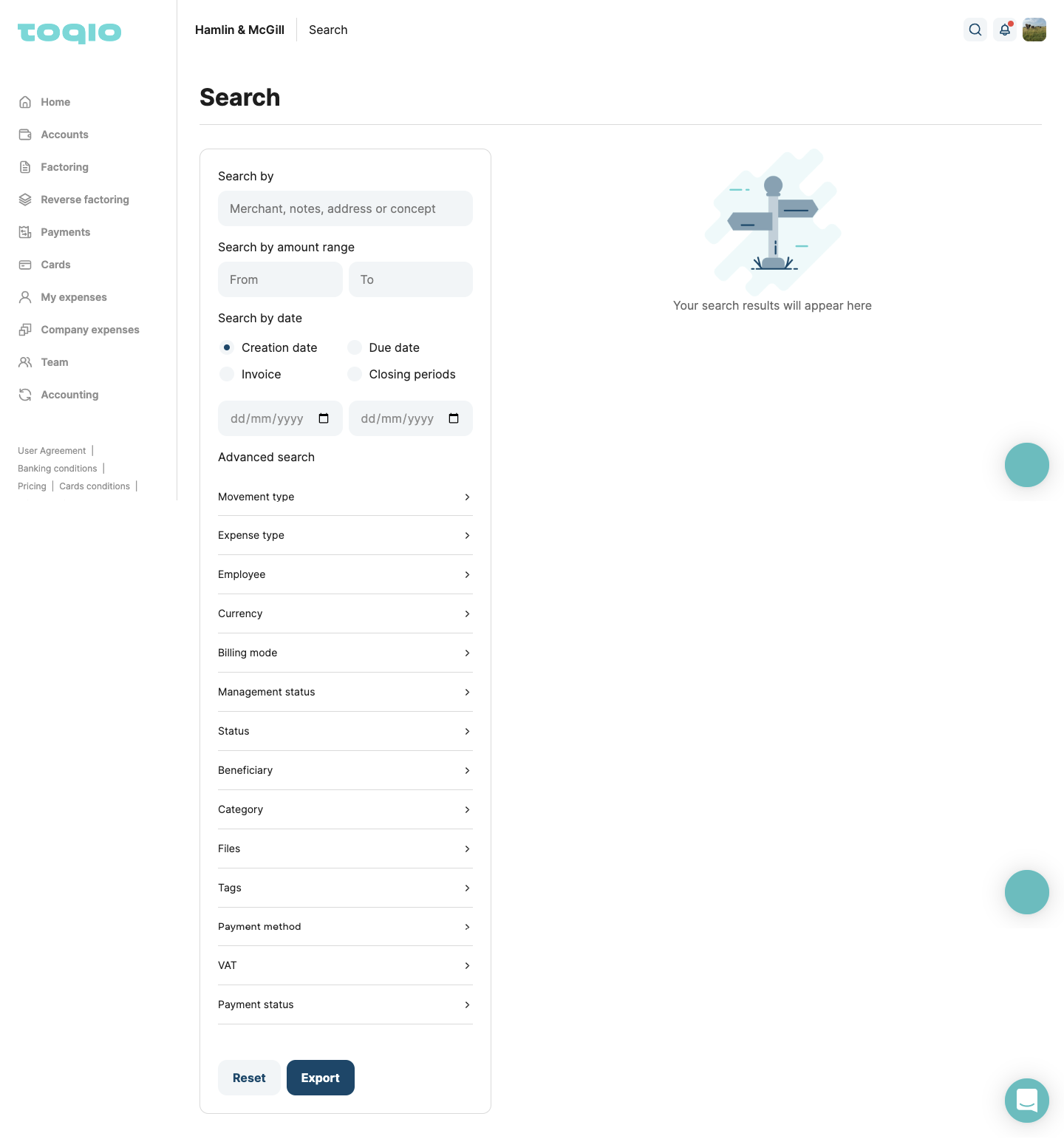
Once the user ends the search customisation, on the left column all results will be shown:
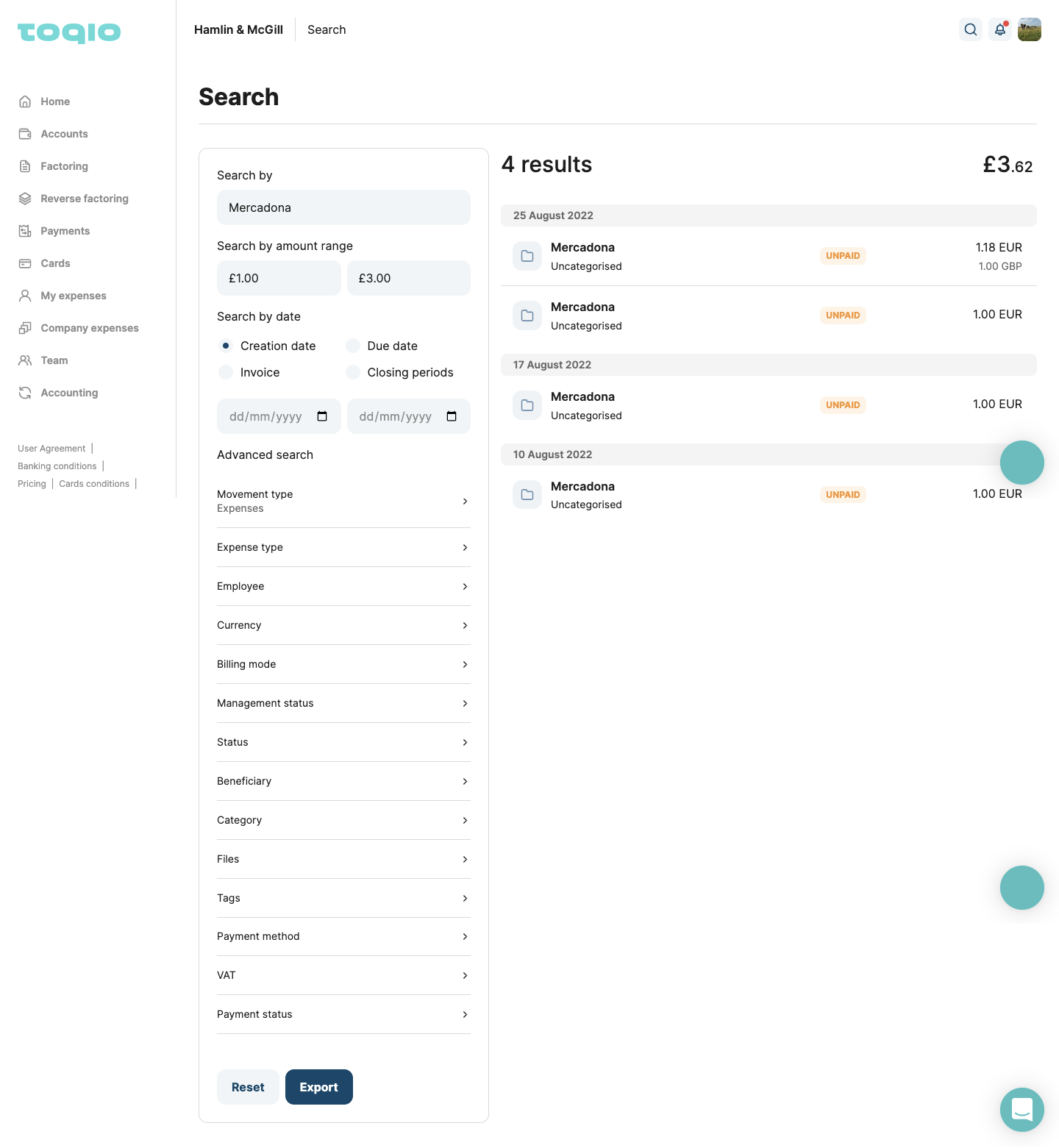
Employee search view
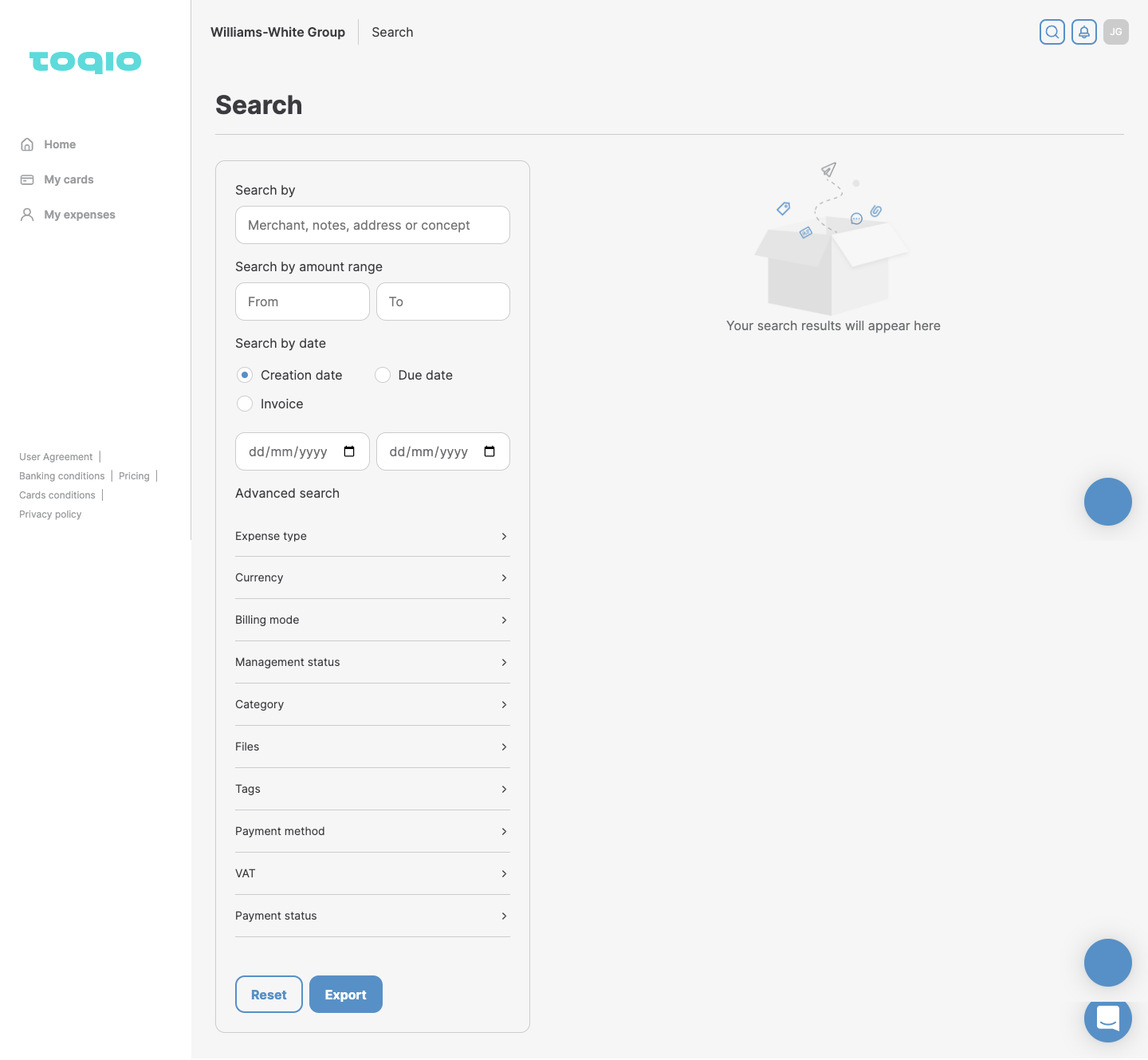
Consumer
As detailed below, the main differences between SME and CONSUMER are the advanced search fields available for search; reduced or modified in CONSUMER's case according to the platform's needs.
Search by:
- Fields input (as described above)
- Amount range (as described above)
- Date (as described above)
Advanced search:
- Category (as described above)
- Transaction owner:
- Role: only Account Owners will have this option available
- Multi-selection: by selecting the users included in the transaction owner list shown. Transaction owners can be Account Owners and/or cardholders.
- Search by (transaction owner): you can also search by directly typing the transaction owner's name, based on predictive and autocomplete search
- Beneficiary (as described above)
- Movement Type: types to be selected by radio buttons are: INBOUND PAYMENTS and OUTBOUND PAYMENTS
- Currency (as described above)
- Files (as described above)
- Payment status (as described above)
Account owner search view
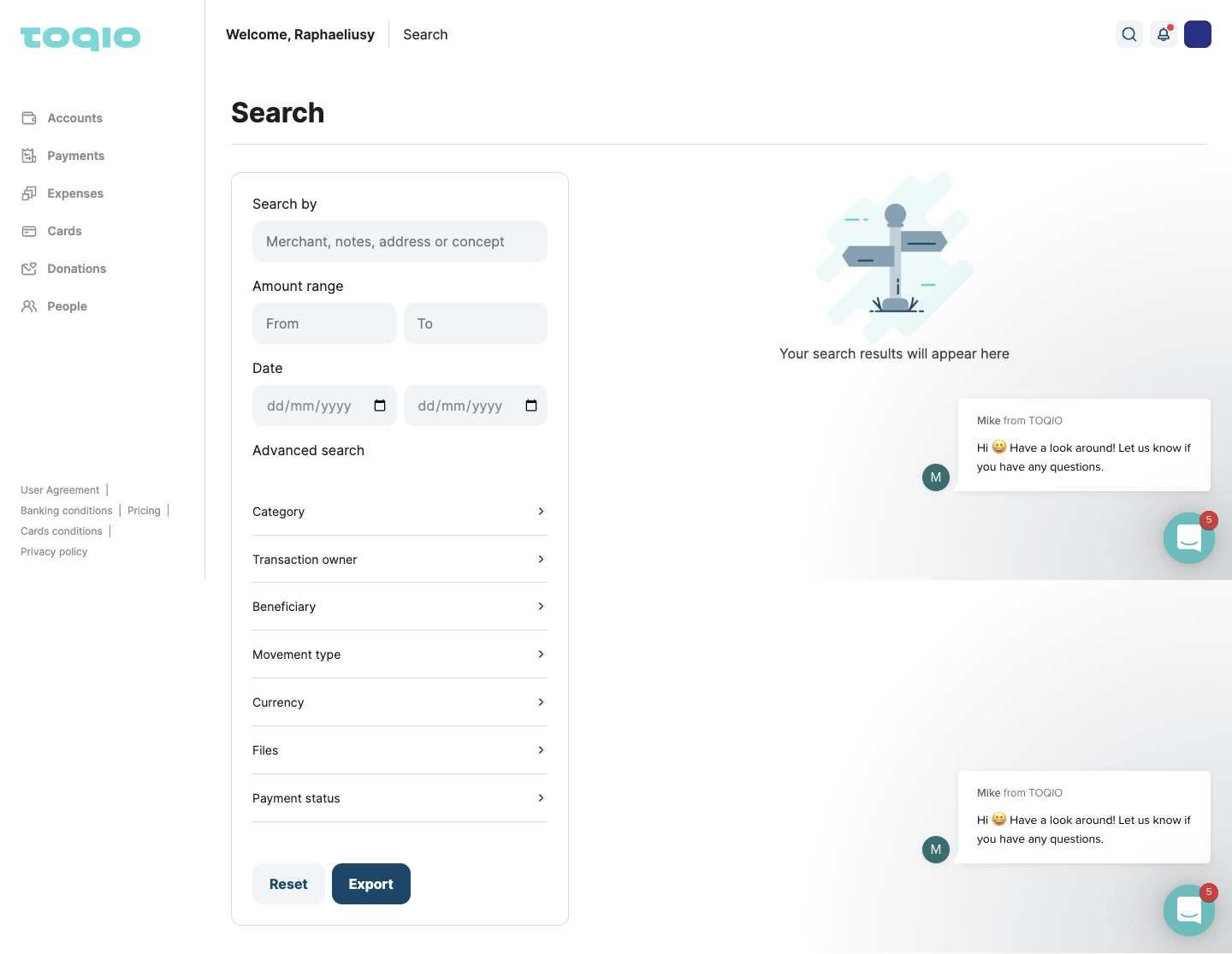
Cardholder search view

_As a user I want to see a search result:
- _Once a search is defined by the user, results will be visible in the right column. Depending on the selection made according to the different fields, the search will be based on:
- If no parameters are defined yet, the user will see an empty state with copy: Your search results will appear here
- If results are not found based on the parameters selected, they will see an empty state with copy: The filter combination has no results. Please try different criteria
- If results are found: a list of transactions will be shown, as follows:
- Total results of the search (left margin aligned)
- Total amount of the search (right margin aligned)

- The item list is grouped by date, the same as in the 'Account' movement list. Each transaction will contain:
- Transaction title: merchant, beneficiary, sender
- Base amount (+ or -) and base currency
- If that's the case, the amount (+ or -) and currency
- If expense:
- Category icon: (if it exists; created by users)
- Transaction title: merchant
- Category name below transaction title (if it exists; created by users)
- If no category was assigned, the default icon and 'uncategorised' category name will be shown

- If Inbound:
- Category icon (if it exists; created by the user)
- Sender name
- Category (if it exists below sender)
- If no category was assigned, the default icon and 'uncategorised' category name will be shown
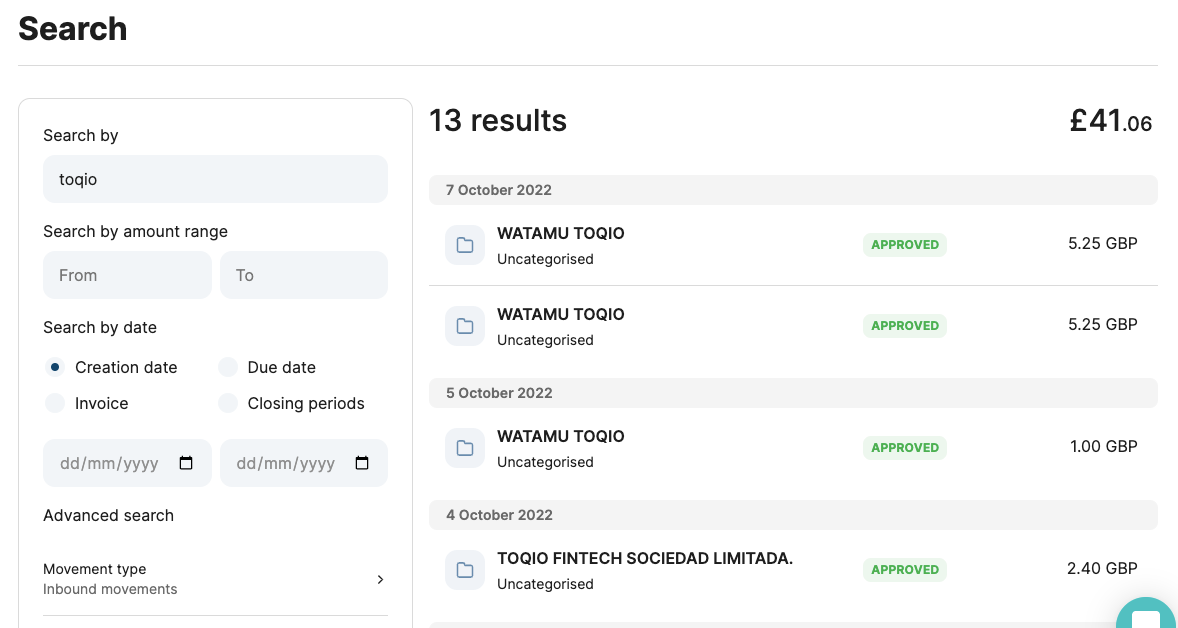
- If Outbound:
- Category icon (if it exists; created by users)
- Beneficiary name
- Category (if it exists; below beneficiary)
- If no category was assigned, the default icon and 'uncategorised' category name will be shown
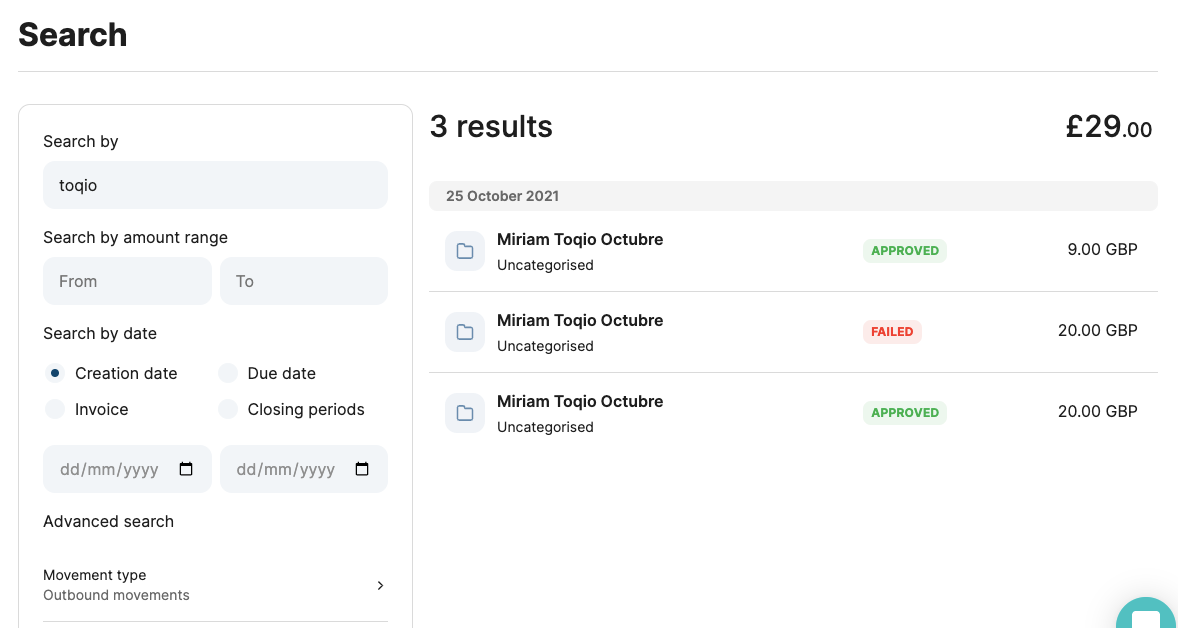
- If Cards (SME only)
- Category icon (if it exists; created by users)
- Cardholder name
- Category (if it exists; below cardholder)
- If no category was assigned, the default icon and 'uncategorized' category name will be shown
As a user, I want to reset my search:
In case a user wants to reset the search, the 'Reset' button will always be available at the bottom of the page, next to 'Export'.
Once the user selects it, any previous selection or filter will be removed and the user will be able to start again and search for new queries.

Updated 7 months ago
